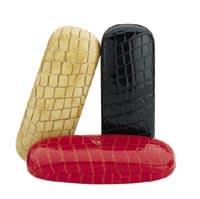Accessories How accessories can add up as add-on sales By Marcy Bruch Even though most optical retailers admit that their eyewear accessories represent only two percent of their overall sales, those who have committed to this product also observe that when they showcase this classification with a bang, business gets a boost. Consider the case of Julie Schmidt, owner of The Bent Lens in Bozeman, Mont. "We started selling Croakies leashes because we're close to two big ski resorts-Bridger Bowl and Big Sky," says Schmidt. "They sold so well among skiers that we decided to expand our chain offering into something more pretty." That said, Schmidt bought into Bastuli chains that retail from $35 to $70 as well as pen readers that retail for $50, and watched her accessory business grow from two percent of sales to five percent within a year. And why does Schmidt think the Bastuli chains sell so well? "Because of the way they are packaged," she answers. "When accessories are packaged pretty, people see the value of them as gifts. In fact, I would say half of the people who purchase the chains are buying them as gifts," she notes. Realizing that, Schmidt then ran a local advertisement last spring featuring chains as a Mother's Day promotion.
Novelty Sells Other unusually packaged accessory items include pen and lipstick readers. "Our customers have a blast with these readers, because when they pull them out of a pen, they think it's the coolest thing going," says Ed Muller, owner of Muller Optical in Albuquerque, N. M. Schmidt even came up with a creative way to advertise those pen readers. She placed the company's logo on the pens and gave them to a number of local restaurants. "When restaurant customers can't read the menu, the waiters offer them pen readers with our logo on it," explains Schmidt, "Invariably they want to buy them, so the waiters direct them to our store. It's a win-win situation, because they're offering their patrons an added-value service and we sell an unbelievable amount of pen readers." Easy Accessibility Beyond packaging, optical retailers also point out that since most accessories are impulse items, they must be presented through compelling displays that allow customers to easily touch and feel the product. "Unlike frames where customer service is mandatory, the displays must be powerful enough to act as an additional salesperson," maintains Bob Giesbrecht, director of merchandising for Kings Optical Group of Canada. The Winnipeg, Manitoba-based company, which has 100 optical chains throughout Canada, recently initiated a test market to outpost accessories in 15 locations. "The accessory outposts have only been up for a month now, but our first round of surveys had feedback that said customers respond well to the outposts because the accessories are more prominently displayed and visible." Giesbrecht says that although each accessory area varies in size, they all feature signage that reads in bold letters: Accessories. "Regardless of how large or small the area is, the outposts are always positioned in high traffic locations and merchandise is always accessible to touch and feel," points out Giesbrecht. Product in the outposts run the gamut from cords, chains, cleaners, cloths, and repair kits, to cases and readers, with retails ranging from $3 to $45. "Our goal is to increase our accessory sales from two percent to seven percent of our business," Giesbrecht says. Robert Sarasohn, owner of Grove Opticians, which has three locations in Boca Raton, Fla., believes that every accessory that's sold with frames takes five percent off his cost of goods. "My cost for goods is 38 percent with frames and lenses, but when I kick in an accessory item-like a European-made case for $40-it reduces my cost of goods to about 33 percent," he maintains. Like other optical retailers, Sarasohn observes that it's the novelty items that sell best. "My customers like all the bells and whistles," he notes. Sarasohn sites the Rem pen reader as a big seller but he also does a big business with European-manufactured cases. "I go to Mido and Silmo every year and buy unusual cases made of beautiful leather and novelty fabrics with rhinestone embellishments. They're different so of course they sell," he says.
Big Ticket, Bigger Margins And while it's easy to sell functional items for $5 like cleaners and repair kits, those who have been successful selling accessories believe the fastest way to boost margins is by offering higher-ticketed items that retail around $50. Kerstin Zeitler, O.D. for Eyecare Clinic in Charlotte, N. C., does a huge presen-tation of readers, chains, and cases. "A coordinating reader, chain, and case package can add up to about $70," says Zeitler. She observes that women are drawn to the colorful readers with cases and chains to match. Men, however, gravitate toward the pen readers from Ron's Optical that she places next to the cash register. "Customers start opening and closing the pen and it sells automatically sells," she says. Which proves, once again, how important accessibility is when selling accessories. Schmidt sums up a final point to keep in mind: "Put accessories in a high traffic area where everyone can feel and touch the product and the whole classification basically sells itself." EB
|
Article
Accessories
How accessories can add up as add-on sales
Eyecare Business
February 1, 2001






